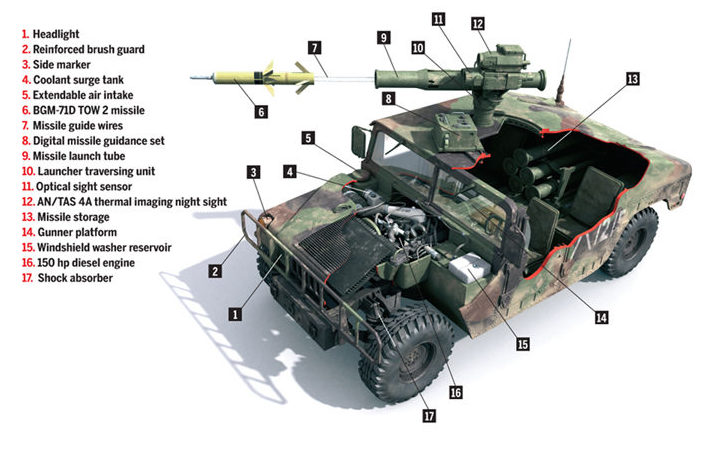
M998 HUMVEE SPECS
- Length: 15 feet
- Width: 7 feet 1 inch
- Height: 6 feet
- Ground clearance: 16 inches
- Engine: General Motors DDA 6.2-liter V8 diesel, generating 150 hp at 3,600 rpm
- Transmission: Automatic with maximum input torque of 451 pounds/foot
- Steering: Power-assisted
- Curb weight: 5,200 pounds
- Payload: 2,500 pounds
- Gross vehicle weight: 7,700 pounds
- Maximum towed load: 3,400 pounds
- Maximum highway speed: 70 mph
- Fuel capacity: 25 gallons
- Range: 350 miles
After the Vietnam War, the U.S. Army underwent a modernization program, which included finding an all-terrain replacement for its tactical vehicles—from the ¼-ton M151 Mutt through the 1½-ton M561 Gama Goat—with the added capacity to carry the new TOW anti-tank missile.
AM General, Chrysler Defense and Teledyne Continental all submitted prototypes, and in late 1982 the Army selected AM General’s design for production as the M998 high-mobility multipurpose wheeled vehicle, or HMMWV (universally referred to by service members as the Humvee).
Production kicked off in April 1984 at AM General’s plant in Mishawaka, Ind., and the first Humvees entered service in October 1985. To offset their relative high cost ($20,410 for the basic vehicle to $28,382 for the weapons carrier), the Army relied on beefed-up Chevrolet Blazers as M1008/9 CUCVs (commercial utility cargo vehicles) in logistics and support roles for which the Humvee’s off-road abilities were not needed. Both vehicles used the same General Motors 6.2-liter V8 diesel engine.
By 2005, AM General had rolled out more than 175,000 Humvees in a range of configurations. Its versatility has outshone that of the legendary jeep, though its use in guerrilla-dominated combat environments such as Iraq and Afghanistan has revealed its vulnerability to mines and improvised explosive devices (IEDs). Efforts to thwart such threats have included various armor upgrades seemingly as improvised as the devices they are meant to counter.
Meanwhile, the Army has embarked on its latest modernization efforts, including plans to replace the Humvee. MH





